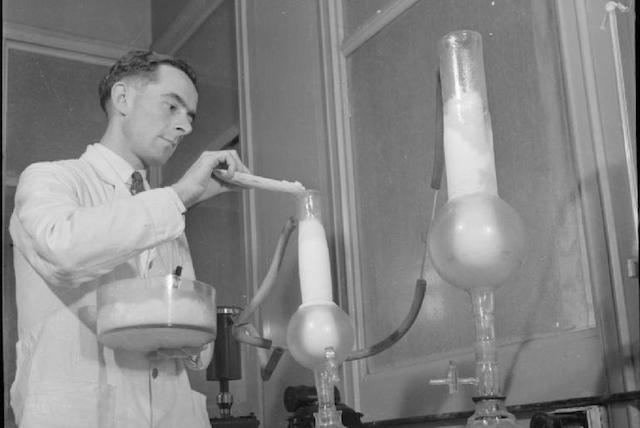"To seal hermetically," after the alchemist Hermes Trismegistus, means to seal something in such a way, usually by magic, that it can never be opened. The next ten riddles—a list of boxes, tombs, and scrolls, plus one letter—are not necessarily magically sealed, but none have ever been opened.
10. Letter from Queen Elizabeth II

In November 1986, Queen Elizabeth II wrote an open letter to the people of Sydney, Australia. But the letter arrived sealed, with the stipulation that it was not to be opened for another hundred years. So until 2085, on a date chosen by the Lord Mayor of Sydney, the contents of the letter will remain a mystery – kept in a vault in a restricted area of Sydney’s Queen Victoria Building. She didn’t even tell her own staff what it said.
Could this be more Sydney-style revelations of royal paedophilia? Could this be a death decree separating Australia from the Commonwealth? Or could it be that he is ceding the throne to his rightful heirs, the descendants of Australian farmer Mike Hastings?
Boringly, it's assumed to have something to do with protecting the building she now occupies, named after her great-great-grandmother, from demolition. It suffered that fate once before, in 1959, when developers had plans for a parking lot. Then, in 1984, a Malaysian company signed a 99-year lease on the building.
9. Boxes of Boguslav Irus

In 1901, Croatian botanist, pharmacologist, philanthropist and explorer Bohuslav Jiruš left most of his worldly possessions to the National Museum. But the secretive professor (of whom no photographs exist) had a sense of humor; he left his estate in two wooden boxes and said they were not to be opened for 200 years. In 2022, with 79 years to go, museum staff realized they could use computed tomography (CT) scanning to view the contents without actually opening them and therefore technically ignoring their benefactor’s will.
Hoping to satisfy their curiosity while they were still alive, they put the dilemma to a vote – asking 3,000 members of the public what they thought. To their disappointment, 53 percent voted against CT scanning. So the guesswork began again.
Given the weight of the boxes, it is thought that they may contain objects made of copper – perhaps some kind of device? Others believe that the boxes may contain botanical or pharmacological discoveries – medicinal plants or dangerous bacteria. At the very least, it is assumed that there will be a photograph of the man in there somewhere, and we will finally know what he looked like.
8. Tomb of Alexander the Great

So this one was opened - and looted - again and again by such luminaries as Cleopatra (to finance her war against Augustus), Caligula (to steal his breastplate), and Caracalla (to steal his tunic, ring, and belt). But nature, not men, has since sealed it, and it has not been opened since ancient times.
It is believed that the tsunami of 365 BC that flooded Alexandria cut off access to the tomb. In fact, it is thought to have sunk to the seabed along with much of the ancient city on which the modern city is built. But there are other theories. It may, as Ambroise Schilizzi suggested in 1850, be in the Nabi Daniel Mosque in Alexandria, but permission to excavate it was never granted. It may not be in Alexandria at all. One theory suggests that a tomb in Vergina, Greece, commonly thought to be that of Philip II of Macedon, is actually that of Alexander the Great. Another suggests it is in Venice, in the tomb of St Mark beneath his basilica. Yet another theory says it is in the Siwa Oasis in western Egypt.
Yet back in Alexandria, Greek archaeologist Calliope Limneos-Papakosta has been searching for decades, most recently pumping out water to facilitate her excavations. To date, she and her team have discovered the city’s first roads and what they believe was the ancient royal quarter. This, she said in 2023, is where the conqueror is believed to be buried.
7. The En-Gedi Scroll
Discovered more than 50 years ago in a damaged Holy Ark near the Dead Sea, the 2,000-year-old En-Gedi Scroll had been burned and turned into an indestructible piece of charcoal. Opening it was out of the question; even handling the scroll risked turning it to dust. Archaeologists had no choice but to set the ancient document aside and forget about reading its contents.
Until recently. In 2015, computer scientist Brent Seales used his revolutionary imaging software to “virtually unroll” the scroll. First, he scanned it with X-rays using a micro-CT scanner. Then he mapped it onto a 3D computer model of the scroll, which, given its irregular shape, was harder than it sounds. Finally, he digitally converted the shape into a flat page.
Although the scroll was fragmentary due to damage to just 35 lines of readable text, it contained chapters of Leviticus (one of the first five books of the Torah). Written in ancient Hebrew, it allows researchers to better understand the early history of the text. In fact, it is the earliest copy of any book of the Pentateuch ever found in the Holy Ark.
6. Mysterious Safe

When New York farmer Kirk Mates returned to his fields from a trip out of town, he was puzzled to find a 600-pound metal safe. There was no indication who had left it or what was in it. But there was a note: “If you can open this, you can get what’s inside.”
When the press caught wind of the story, Mathes' farm in Barre, Orleans County, became a media circus. Apparently trying to downplay the safe's significance, he told reporters it had probably been left by local "crazy kids... real pranksters." But crowds still flocked to his farm, some smashing the safe with sledgehammers, damaging the hinges and knocking off the handle and dial.
After calling the police and hiding it, Mathes said he planned to leave it unopened. Although the intensity of interest bothered him, he felt the mystery was fun enough to keep. “If you open it,” he said, “the show’s over.” The plan now is to place the safe in a local history museum. “It could contain millions of dollars. It could contain confetti,” said Cindy Vanlihout of the Barre Beautification Committee. “You have no idea, so just dream.”
5. Tomb of Cleopatra

According to archaeologist Kathleen Martinez, who has been searching for Cleopatra’s tomb for more than three decades, “Cleopatra outsmarted everyone.” She evaded the smug Roman Emperor Augustus by committing suicide, and then even denied the Empire her corpse, taking it with Mark Antony’s to a location that remains secret to this day. The most likely location is Taposiris Magna, a temple outside Alexandria, Egypt. But it’s been many years since Martinez and her team discovered “spectacular artifacts” associated with the queen there, including coins and figurines of Isis.
But as recently as 2022, they discovered a spectacular tunnel cut into the sandstone rock, 13 metres deep, two metres high and 1,305 metres long. Its design, described by experts as a “geometric marvel”, is reminiscent of the Tunnel of Eupalinos on Samos, built in the 6th century BC. The tunnel is a promising lead, but like the previously discovered network of tunnels connecting Lake Mariout to the Mediterranean, it was partially submerged by earthquakes between 320 and 1303 AD.
If discovered, Cleopatra's tomb would be the most important archaeological find of the 21st century. Martinez already knows what her first words will be if she reveals it: "The world has never forgotten you, Queen Cleopatra."
4. Herculaneum papyri

Discovered in another Pompeii, Herculaneum, in the late 1700s, the Herculaneum Papyri number around 1,100 papyri in total. Found in a luxurious villa that belonged to Julius Caesar’s father-in-law, they represent a tantalizing “invisible library” full of unprecedented glimpses into the classical world. In fact, the Herculaneum Papyri represent the only classical Greco-Roman library to survive to this day. The only problem is that the eruption of Mount Vesuvius turned them into black, unbroken lumps of charcoal.
Over the centuries, researchers have tried to get to their contents, often destroying the scrolls in the process. (Many were destroyed, either thrown into the sea or burned as charcoal, before their discoverers even realized what they were.) Their first archivist, Camillo Paderni, cut some in half, copied the visible text, then scraped off each layer in turn. A couple of years later, Vatican restorer Antonio Piaggio glued ultra-thin, ultra-strong calf intestine to the surface of the scroll, then used weights and ropes to carefully separate each layer so artists could copy the contents. But the method was far from perfect, with many layers sticking together and tearing. Since then, the scrolls have been hidden in secret vaults to protect their contents until we can somehow open them properly.
Now, judging by the “virtual unrolling” of the En-Gedi scroll, that time appears to have arrived. The same computer scientist has collected up to 12,000 cross-sections of the papyri he was allowed to examine, and is now relying on artificial intelligence to sort the jumble of letters by density. Unlike the En-Gedi scroll, the authors of the Herculaneum papyri did not use metal in the ink. If successful, the scrolls would usher in a new “renaissance of classical antiquity,” potentially changing the canon. But archivists are understandably cautious. Even handling a papyrus can turn it to dust. So far, Seales has only produced two images, and he still needs to wait for the AI to improve.
3. Joanna Southcott's Box

Self-proclaimed Apocalypse Woman Joanna Southcott sold “Seals of the Lord” to suckers, guaranteeing each buyer one of 144,000 places in Heaven. She even seemed to believe it herself, convinced by visions that she had a sacred mission. Namely, despite being a 64-year-old virgin, she claimed that she was to give birth to a messiah in London—the Shiloh prophesied in the Book of Genesis. In fact, she looked pregnant enough to not only convince herself, but to attract followers (the Community of the Holy Ghost, later renamed the Panacea Society), who built an ornate gold cradle for the baby. In the end, however, Southcott’s bloated abdomen proved to be the cause of her death, and her followers eventually reluctantly buried her corpse.
But she left many more prophecies in a large wooden box, bound as “guided by the Spirit” in the Seven Seals. So at least they had something to look forward to. The problem was that Southcott said it could only be opened in a time of national crisis, and only in the presence of all 24 bishops of the Church of England. The first part was easy. Even in the 1920s, a century after her death, Southcott’s admirers knew they were living in the end times, and that her box would “lead the English nation” to safety. The bishops, however, were not so convinced – not even with a Panacea Society advertising campaign on the sides of London buses, urgently warning the public that “England’s troubles will increase until the bishops open Joanna Southcott’s box.”
Despite a house being prepared for the purpose, the bishops never came. Although a psychic investigator claimed to have opened the box containing the Bishop of Grantham and found books, papers, dice, a lottery ticket, a nightcap, earrings, a purse and a pistol, it was too small to have belonged to Southcott. Today, the real box is hidden somewhere in the English town of Bedford, which the Panacea Society believed to be the Garden of Eden.
2. Repository B in Sri Padmanabhaswamy Temple
Dedicated to Vishnu and run by royalty, the Sree Padmanabhaswamy Temple in Kerala, India, is one of the most secure sacred sites in the world thanks to its underground vaults. The building is now monitored by CCTV cameras, metal detectors and hundreds of machine-gun-toting guards. Until June 2011, no one even knew what treasures it held; a Supreme Court order was required to access the “mega” secure underground vaults.
Among the items found were a solid gold idol of Mahavishnu, four feet high and three feet wide, studded with diamonds and precious stones; a solid gold throne for an 18-foot idol of the god; thousands of gold chains (one 18 feet long); solid gold coconut shells studded with emeralds and rubies; gold elephants; and sacks full of gold coins from the Roman and medieval eras. The haul was valued at approximately $22 billion.
However, one of the six vaults, Vault B, was exempted from the court order because it is not part of the temple’s treasury. To this day, it remains unopened. But not for lack of trying. Apparently, one of the temple authorities’ attempts to break the lock was stopped when they heard the sound of crashing waves on the other side of the door, leading to the belief that it opened onto the Arabian Sea. The vault is also believed to be guarded by poisonous snakes, vampires, and magic. There are also rumors of another, even more secret room with solid gold walls and the largest cache of undiscovered treasure in the world.
1. Tomb of the first Chinese emperor

At the end of the Warring States period, Qin Shi Huang unified China under a centralized imperial rule. Politically, this changed the Middle Kingdom forever. Personally, however, it reinforced the new emperor’s lifelong obsession with immortality, giving him access to unprecedented resources and manpower. As a child, long before he became the first emperor, Qin Shi Huang had planned this. Now he could issue edicts for everyone in the country to join him in his hunt for the elixir of life.
He could also begin work on his underground necropolis, where (as a backup) he planned for his body to lie in peace until it could be resurrected. In Shaanxi province, archaeologists have discovered the famous Terracotta Army, life-size replicas of ancient warriors. But this find, significant as it is, represents only a tiny part of a still-unexplored 6.3-square-kilometer burial complex.
The underground city, built by 700,000 people over 38 years, is said to hide: picturesque palaces and towers; priceless artifacts; many, many more terracotta warriors than have ever been discovered (and in their original purple color, undamaged by daylight); and a complete mechanical replica of China’s river network, filled with mercury. It’s that last point that has archaeologists in awe. According to the ancient historian Sima Qian, the tomb is also guarded by automatic crossbows, the exact details of which were deliberately lost to history when their creators were locked inside.













Оставить Комментарий